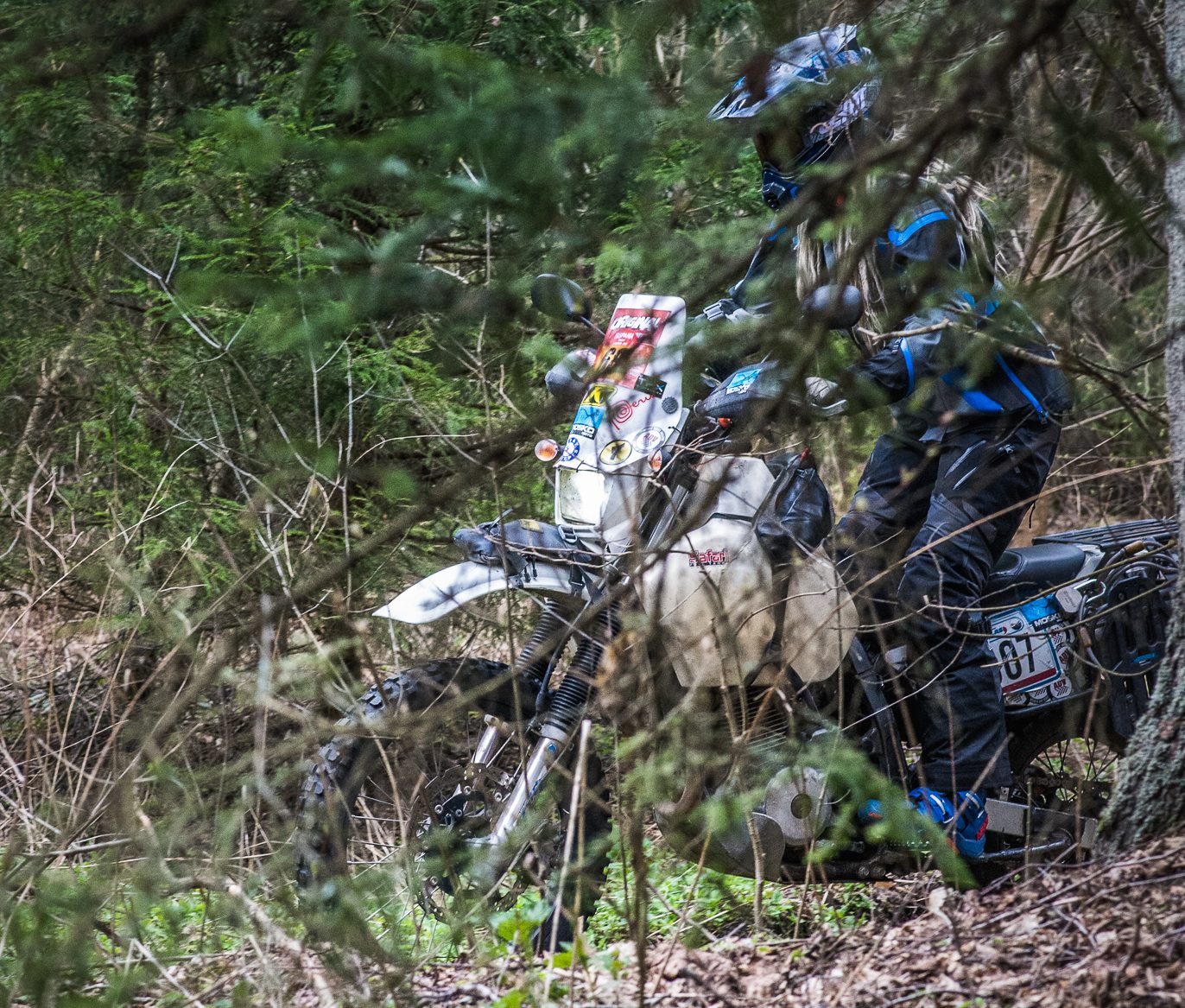
How to Transition from Street to Adventure Riding: a Beginner’s Guide to Start Riding Dirt
Plotting to transition from street to adventure riding? Huzzah! Here at Women ADV Riders, a lot of us came to ADV from street riding (while others came from zero experience at all), but we’re all sworn dirt fanatics for several reasons. New trails to explore, off-the-beaten-path places to see, dirt roads to travel, and exciting adventures to be had – ADV riding has so many rewards we’re seriously stoked you’re here.
As with any transition, though, be it bike or life-related, it’s always a challenge. The good news is, you don’t have to do this alone. We’re here for you! Still, there’s no one-fits-all formula to guarantee instant success. We figure that’s a good thing: learning at your own pace and on your own terms is so much more rewarding, and the only milestones or expectations for your progress should be set by you and you alone. We’ll touch on this a little more later.
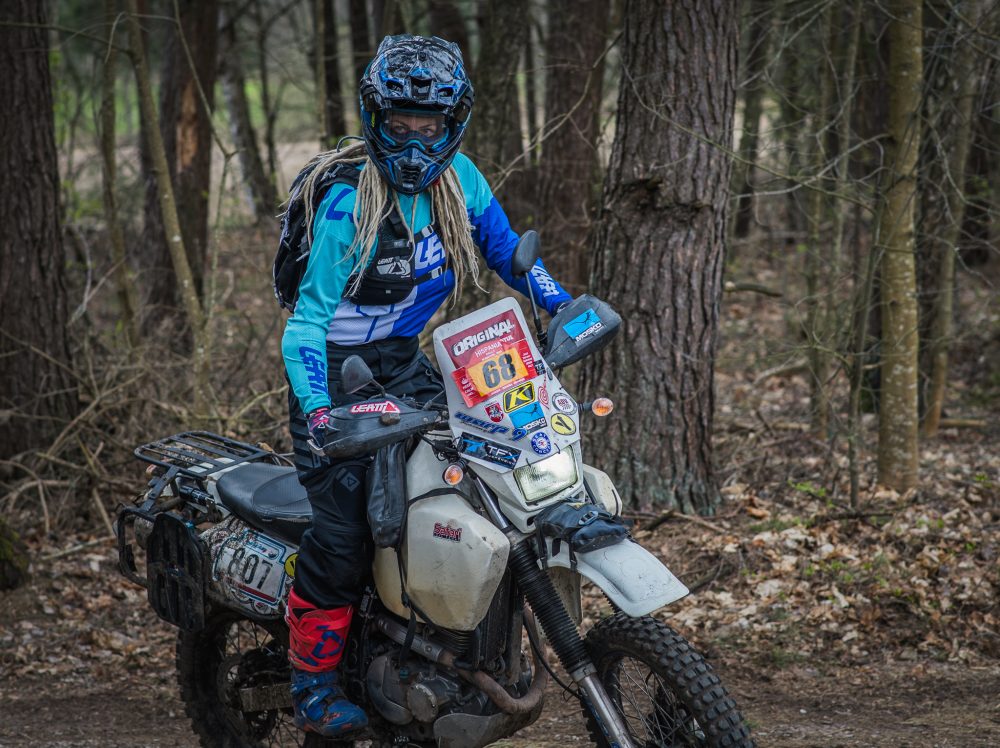
In this article, we’re outlining a comprehensive beginner’s guide to start riding dirt – and encourage you to always, always trust your own instincts and progress in a way that feels comfortable for you. When you transition from street to adventure riding, you’ll find that some techniques feel entirely new (like standing up on the pegs), while others that you already know – like looking ahead – will help you master dirt faster. Use the skills you already have, but be open to new ideas and experiences, and we bet you’ll have a fantastic journey into the world of ADV riding.
So let’s dive right in: what’s the best way to transition from street to adventure riding, what are the best bike and gear options, where to begin, and how to put new skills into practice?
-
Adventure vs Dual Sport vs Dirt: What’s What
First things first: what’s the difference between adventure, dual sport, and dirt riding? We might be throwing too many concepts at you right at the start, but it helps to understand what’s what before you begin – and figure out what sounds like your kind of thing the most.
Adventure riding encompasses both road and off-road riding, but most adventure motorcycles are large road bikes that are capable of tackling dirt. That is, they’re heavier, more comfortable, and more road-oriented than pure dirt or dual sport motorcycles, but they can happily take on gravel, forest service roads, and some slightly more technical terrain once you get the hang of it. Examples of adventure motorcycles include BMW GS850, BMW GS1200, Honda Africa Twin, Triumph Tiger 900, and so on.
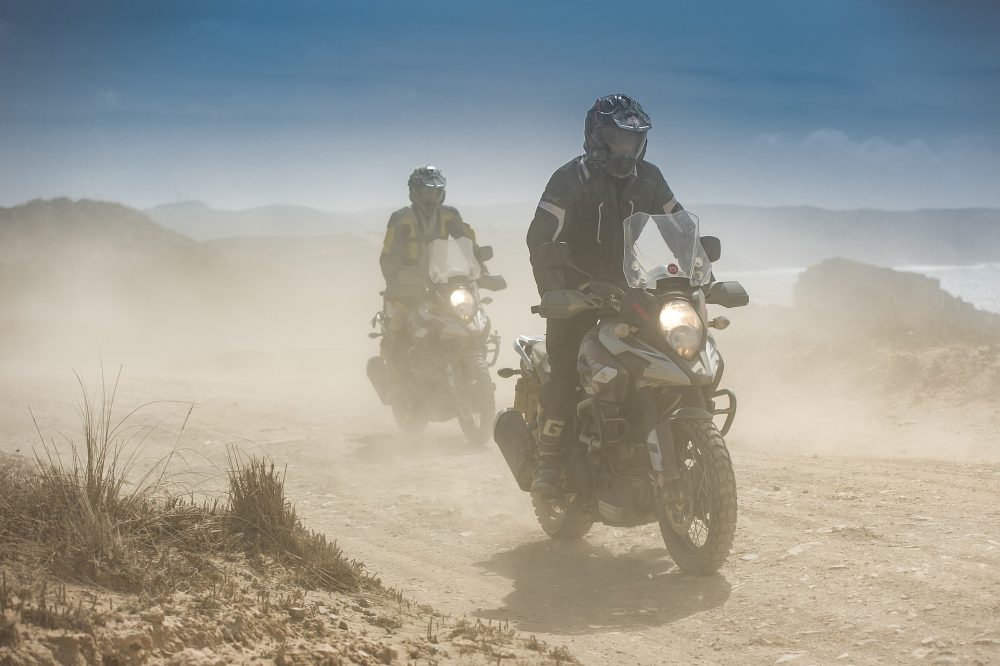
Dual sport riding is sort of the same as ADV, except the other way round: dual sport motorcycles are dirt-oriented bikes capable of decent enough performance on paved roads. They’re typically smaller in capacity than ADV bikes, lighter, and have higher ground clearance for better off-road performance. While they’ll have enough speed and power for paved mountain twisties, they’re happier on off-road trails and can be a lot of fun on any terrain. Examples of dual sport motorcycles are Suzuki DR650, Kawasaki KLR650, Ducati Desert X, Aprilia Tuareg, and the like.
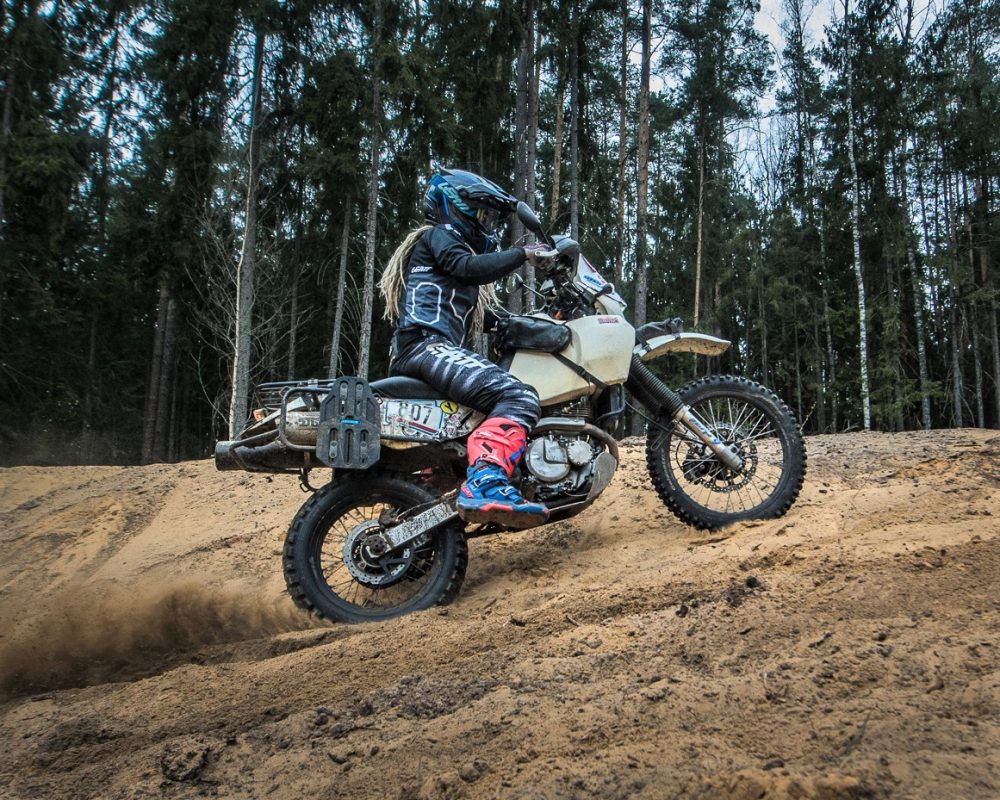
Dirt biking is all about – you guessed it – dirt. Dirt motorcycles are aimed at pure off-roading: forest trails, singletrack, desert riding, and just about anything else that’s dirt. Dirt bikes are small, lightweight, and designed for off-road only. While some may be capable and road-legal to cover some tarmac miles, the primary purpose of dirt bikes is staying off paved roads altogether. Dirt bike examples include Honda CRF250, Husqvarna 350, Yamaha WR250, and the like.
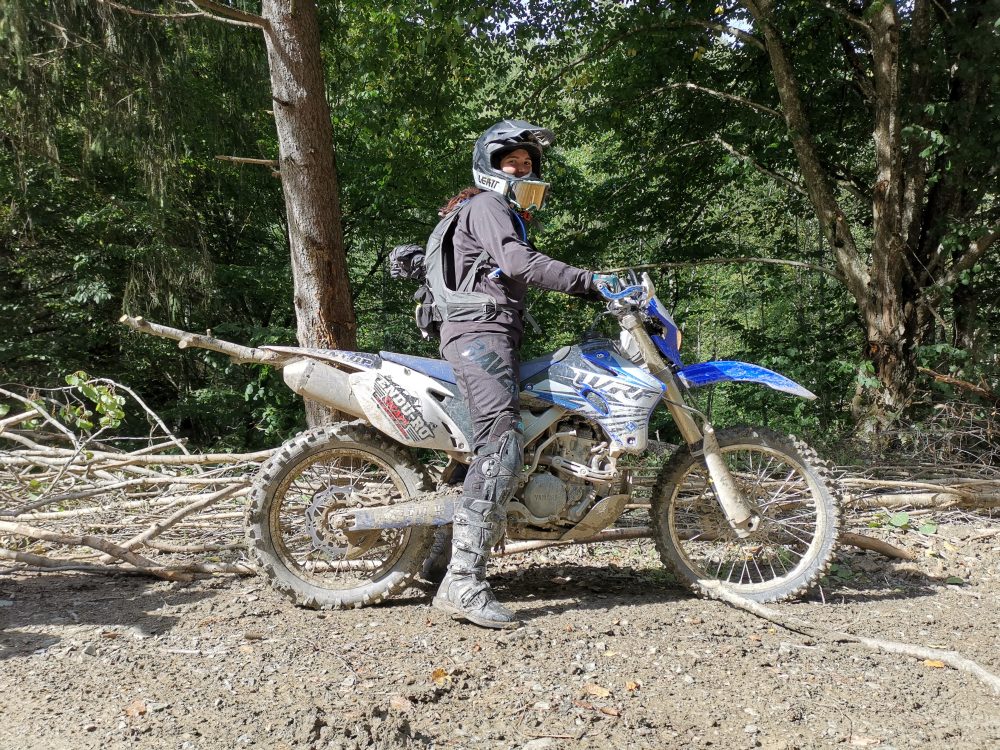
Should I Choose an Adventure, Dual Sport, or Dirt Bike to Get Started?
On the face of it, it seems simple. If you want to get into adventure riding, buy an adventure motorcycle, right? Not quite. When you transition from street to adventure riding, the most important new skill to learn is riding dirt. Even if you don’t plan to be doing any gnarly terrain in the foreseeable future, learning to ride off-road is always easier on a smaller, lighter motorcycle – such as a dual sport or a dirt bike.
Why?
Horses for courses: dual sport and dirt bikes are aimed specifically at off-roading. Adventure motorcycles, as we touched on before, are basically large and comfy road bikes that can be enjoyed on gravel and forest roads and are designed for long-mileage trips.
Lightweight and agile dual sports and dirt bikes are more forgiving, easier to throw around, and confidence-building. It’s so much easier to learn the basics on a smaller dual sport, then graduate to a large-capacity, heavy adventure bike than trying to learn the ropes on a 1200 CC beast. The skills and, most importantly, the confidence you gain on a dual sport or dirt bike will easily transfer to riding an ADV motorcycle, and you’ll have a solid, reliable foundation to build on.
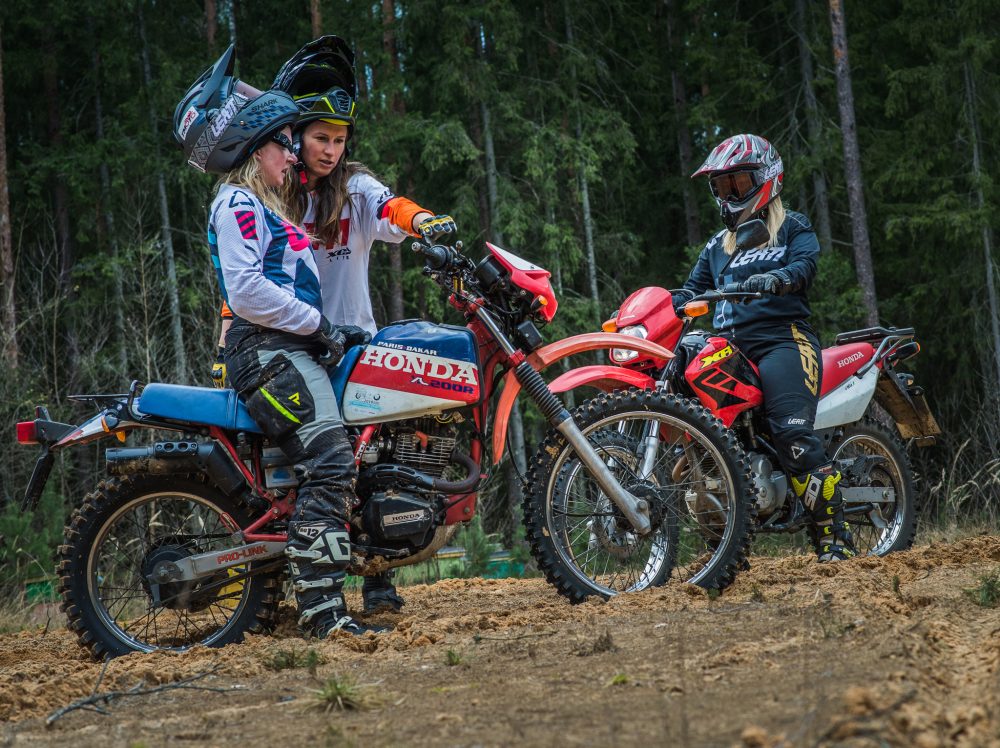
Now, that’s not to say you can’t transition from street to adventure riding on something like a BMW GS1200. You absolutely can, and if that’s your dream bike, by all means, go for it: there are plenty of adventure motorcycle training courses, schools, and events aimed at big ADV bike owners.
However, if you’re not entirely sure exactly what type of riding you’ll end up doing (adventure travel? Road trips with a few gravel roads here and there? Mostly off-road expeditions with a few tarmac liaisons in between?), learning to ride off-road on a smaller, lightweight, dirt-friendly motorcycle will make it so much easier, faster, and, if we’re honest, a hell of a lot more fun.
What’s the Best Starter Motorcycle to Transition from Street to Adventure Riding?
The short of it is, it depends on your goals, skill level, expectations, and budget. If you’re just starting out, we recommend keeping it simple and looking at a few factors:
- Weight, size, and power. If you previously rode something like a Honda Goldwing as a street rider, a 539-pound KTM 1290 Adventure might not seem like a big deal to you. However, if you’re used to smaller urban commuters or scramblers, a large and heavy adventure motorcycle might be a bit too much bike. And, look, it’s not about pushing smaller or less powerful motorcycles onto women riders – male or female, learning to ride off-road on lighter bikes is just easier, period. Another important thing to remember is the motorcycle’s weight vs power ratio: for example, a Royal Enfield Himalayan weighs 439 lbs and has a 411 CC engine, whereas a Suzuki DRZ400 with the same engine capacity weighs a hundred pounds less. The Himalayan looks cooler, but the DRZ is easier and more fun to ride.
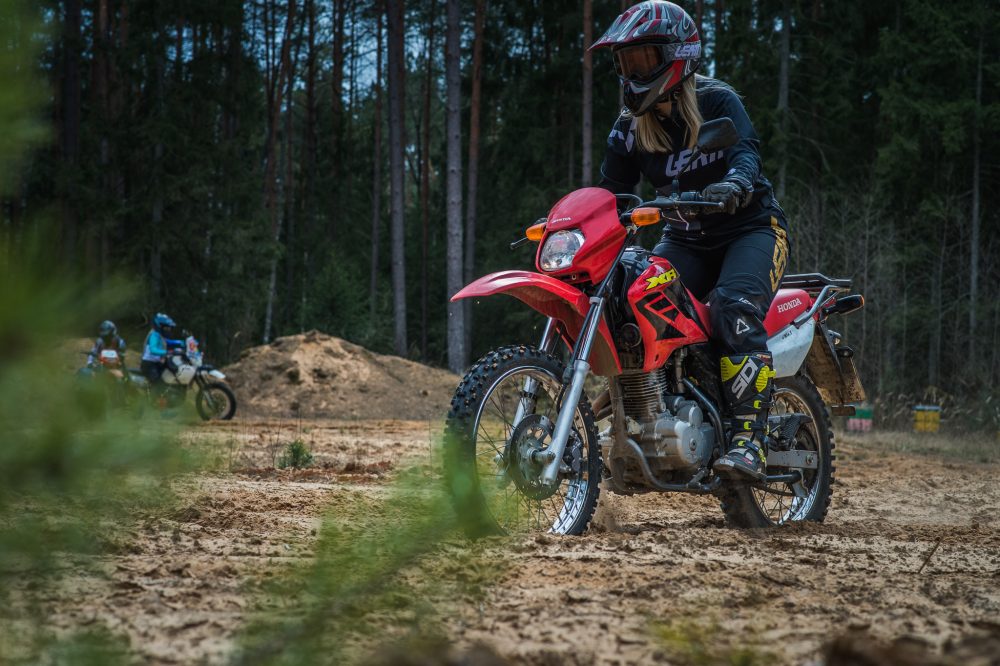
- Simplicity and reliability. Even if you don’t plan to do your own motorcycle maintenance, buying a bike that’s mechanically simple and easy to service means fewer costs, a longer lifespan, and plenty of room for modifications as you progress. Dual sports like Suzuki DR560, Suzuki DRZ400, Yamaha Tenere 700, and similar are all no-frills, sturdy, off-road capable bikes that will serve you for years to come and won’t mind a few drops and bumps here and there.
- Even if budget isn’t an issue, buying a $20,000 adventure motorcycle as your first ADV bike is…brave. These days, motorcycle manufacturers offer plenty of great options hovering at around $5,000 (Royal Enfield Himalayan, Kawasaki Versys X-300) – $7,000 (Kawasaki KLR 650, Suzuki DR650), and these are all fantastic bikes to get you started. Plus, you can always modify and improve them later according to your own needs.
Street to ADV: What Gear Do I Need?
Now that you’ve got your riding types and bike choices covered, it’s time to talk about gear. You already have your street riding gear; do you need anything specific for adventure riding?
Yes, absolutely. Again, adventure motorcycling means riding dirt, and riding dirt may mean involuntary landings on all sorts of different terrain – which is why you need good protection.
Adventure riding gear is typically textile-based, GoreTex-reinforced, four-season gear with knee, hip, back, elbow, and shoulder protection made of abrasion and tear-resistant fabrics. When it comes to women’s adventure riding gear, look at brands like Klim which have a decent women’s gear lineup and offer superb quality and durability.
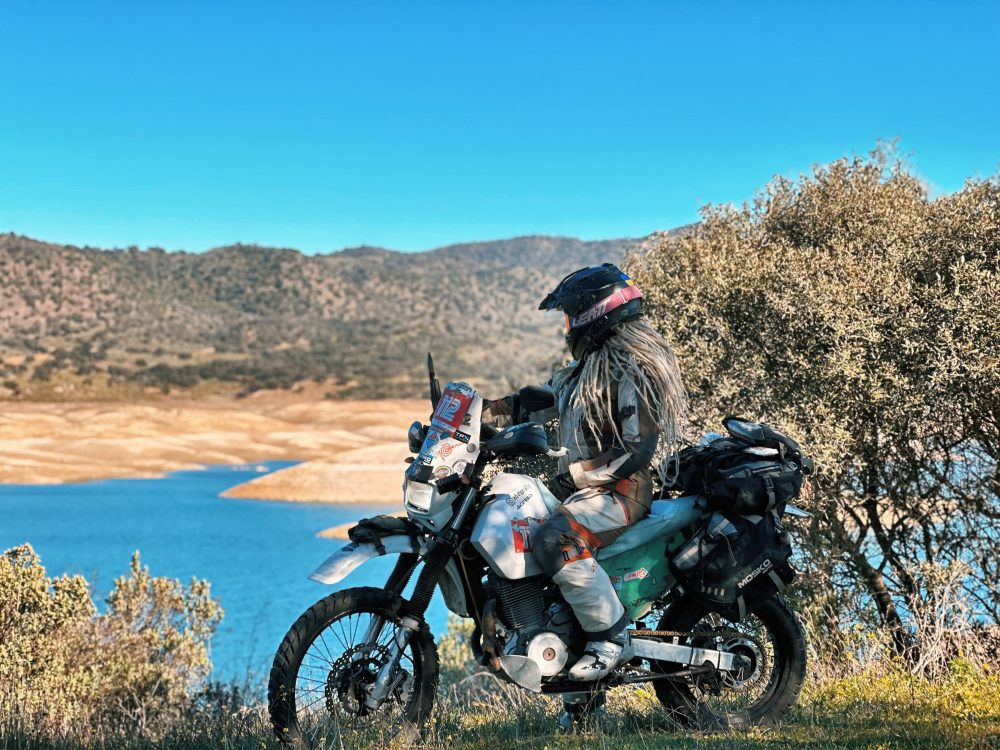
Dirt bike riding gear is usually modular gear – knee braces or pads and body armor paired with lightweight dirt pants and jerseys. Dirt riding armor offers more protection than adventure riding gear, and it’s aimed at riders tackling more technical terrain.
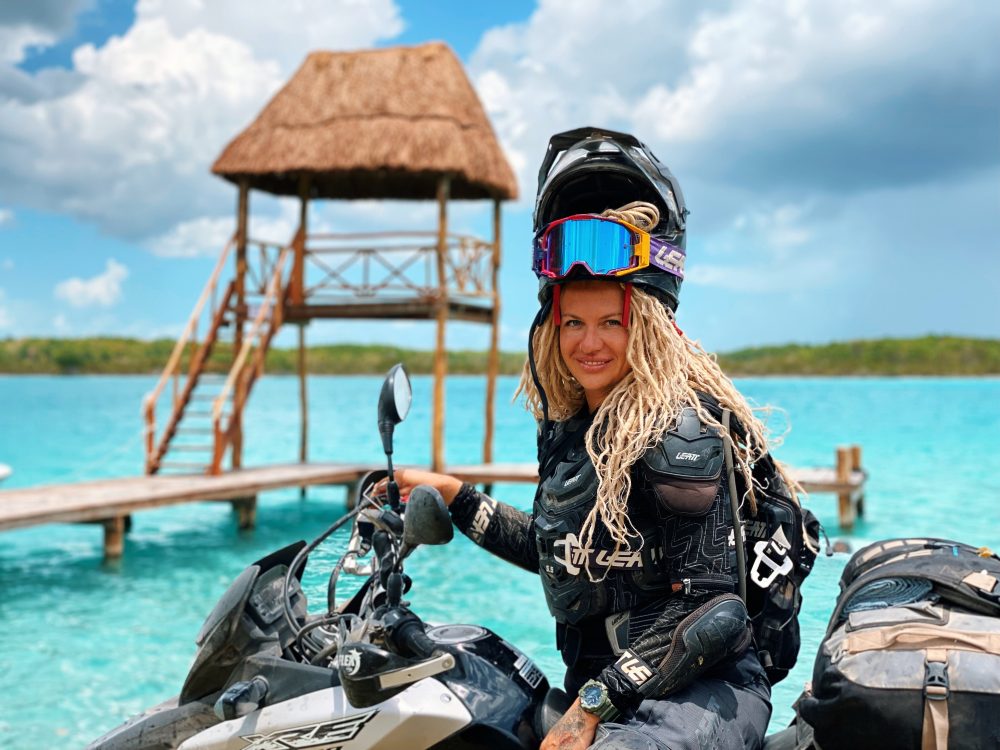
ADV and dirt bike helmets differ from street riding helmets by design and function. Most adventure and dirt riding helmets have a peak that protects you from sunlight as well as tree branches or anything else that might hit you in the face while riding forest trails. Most ADV and dirt bike helmets can be paired with goggles for extra eye protection, and some have extra sun visors for more comfort.
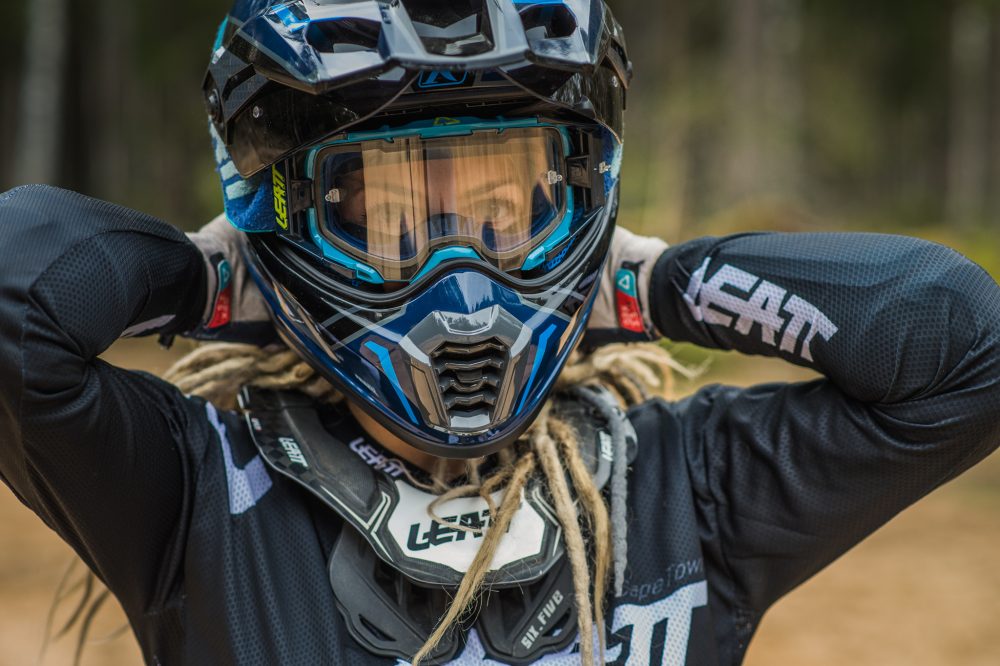
Do you need ADV or dirt riding gear to transition from street to adventure riding? Again, that depends on the type of riding you’ll do, but a set of good-quality, protective adventure motorcycle gear is always a good place to start.
Riding Technique: What’s Different Riding Street vs Dirt?
If you’re an experienced street rider, is it going to be easy to learn to ride dirt? Yes and no. On the one hand, you already have a solid set of skills, you’re confident on two wheels, and you don’t need to start from the very basics. That’s a huge bonus.
However, there’s one key difference between street and dirt riding: traction. On paved roads, your tires grip the surface providing plenty of traction, which is why you can lean into corners at speed without fear of falling over and maneuver easily.
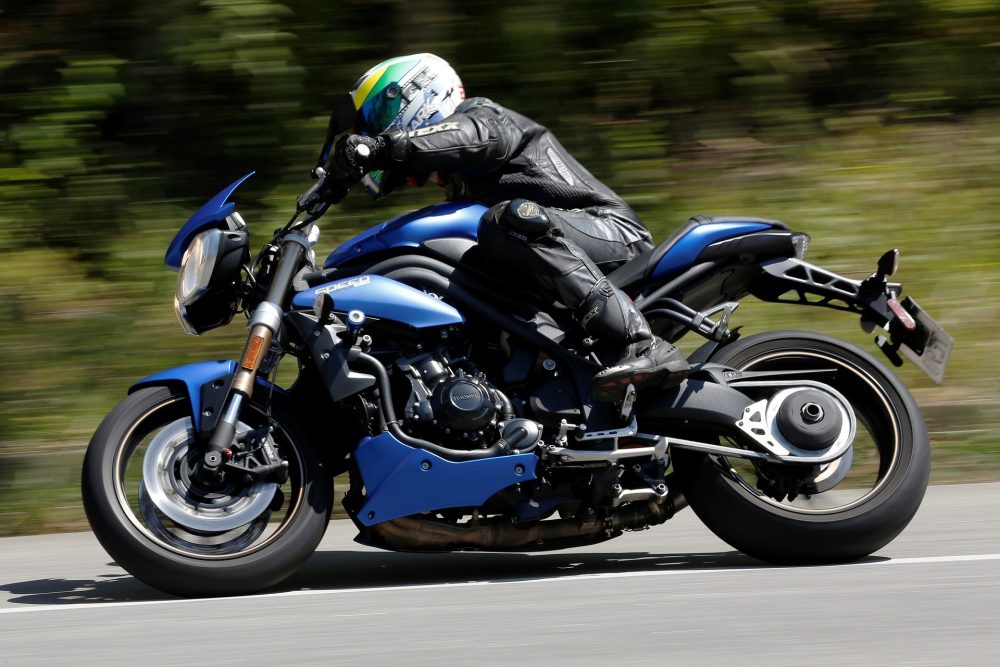
On dirt, however, you lose a lot of that grip. If it’s hard-packed dirt (for example, graded farm roads), the loss of grip and traction is minimal, and you can pretty much ride it as you would tarmac. Loose surfaces, on the other hand (think fine gravel, sand, or mud) mean a significant loss of grip and traction.
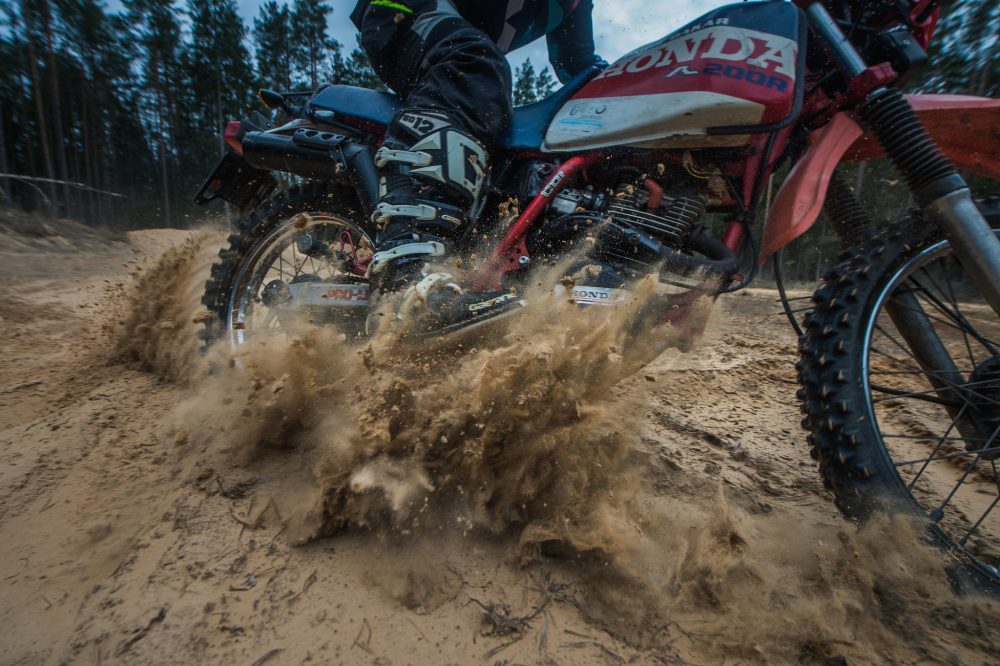
To make up for it, you’ll need to master a new riding technique that’s all about balance, body position, and momentum.
In addition (and because of the loose surfaces), when you venture off-road, your motorcycle is going to move underneath you. It feels unnerving at first: as a street rider, you’re used to the bike being smooth, stable, and steady. On dirt, the bike is going to move, skid, and slide underneath you to a bigger or lesser extent. That’s OK! You heard us right – it’s perfectly normal; riding dirt is all about accepting that movement and learning to go with it rather than against it. At first, it may feel like going against everything you know, but once that switch happens in your brain, you’ll soon find riding dirt is a lot easier than it felt at the start – and, most importantly, you’ll be having a ton of fun in the process.
Transitioning to Dirt: Basic Techniques
Okay, so you’ve got less grip and traction, and your bike is going to move underneath you. How do you ride the thing, then? Ideally, it’s best to take training courses or go on a training tour so you can build a good foundation assisted by a professional off-road coach. Training is key to start enjoying adventure riding faster (and safer!), and professional instructors will teach you more than any blog post, YouTube video, or friends’ advice could ever come close to doing.
If you don’t have that opportunity just yet, though, here are a few pointers that can help:
Standing Up on Your Footpegs
To compensate for the loss of traction on dirt, you’ll have to learn to stand up on your footpegs. When you’re sitting on your bike, you only have two points of control: your handlebars and your weight. When you stand up, you can affect the bike’s movement and speed with your feet, knees, and body position in addition to the first two. This gives you more control and more freedom to move with your bike.
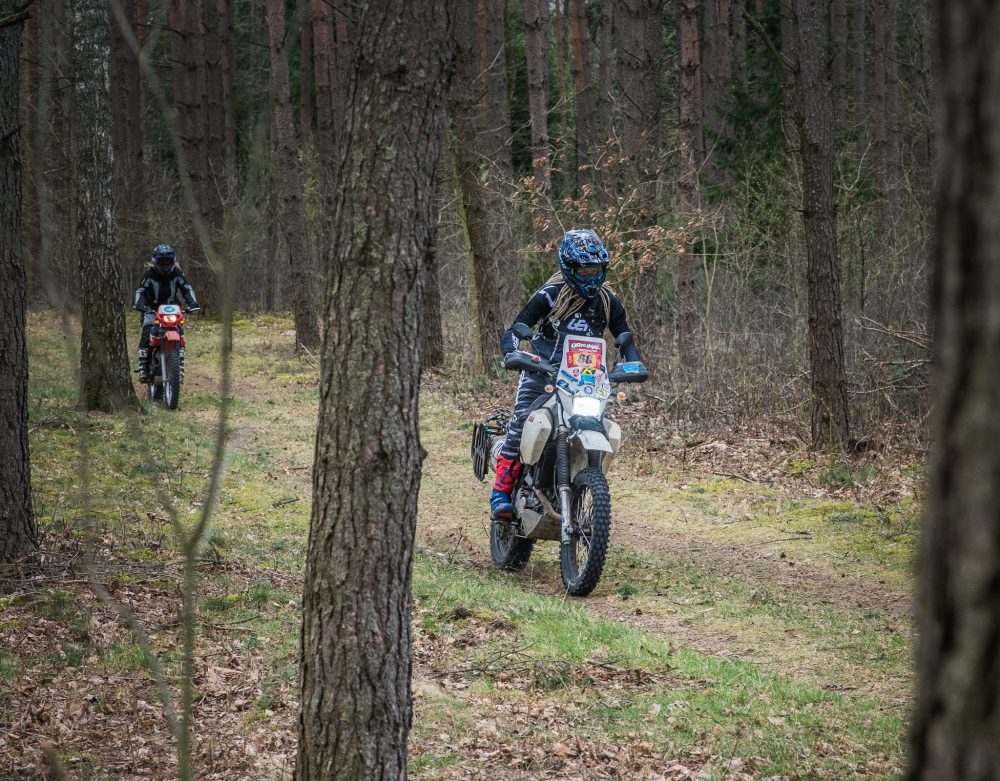
Next, your center of weight will shift downwards – instead of being on your seat, it will now move down to your footpegs. A lower center of weight adds stability and makes it easier to control the bike.
Finally, when you ride standing up, your feet and legs act as shock absorbers allowing you to sort of float over bumps rather than hit each and every one of them and feel it through your back and neck. A standing position also allows you to remain supple, flexible, and balanced, which is key for that fluid, uninterrupted movement rather than stiff bouncing all over the place.
At first, riding standing up feels scary because it looks like there’s a longer way down should you crash, and you can’t “save it” by sticking your leg out. We get it – but the thing is, you’re significantly less likely to tip over when you’re standing in a balanced position than when you’re sitting down. Sanding up on the pegs allows you to have more control, more balance, and more stability.
The Jelly Trick
To learn to ride in a standing position, start slow and easy. Pick a straight stretch of road, get into second gear, keep the throttle steady, and stand up on the pegs much in the same position as if you were standing on the ground. Keep your legs straight (don’t lock your knees, just stand in way that feels comfortable), slight bend at the hips, straight back, elbows out, and relaxed arms and hands on the bars.
Ride slowly and try to find a natural, comfortable position: you don’t need to bend your knees or squat when you’re going in a straight line, and you don’t need to arch your back or contort yourself into unnatural positions. If riding standing up feels uncomfortable, you may need to adjust the bike’s ergonomics for your height – for example, you may need to raise your handlebars if you feel like you’re hunching over too much.
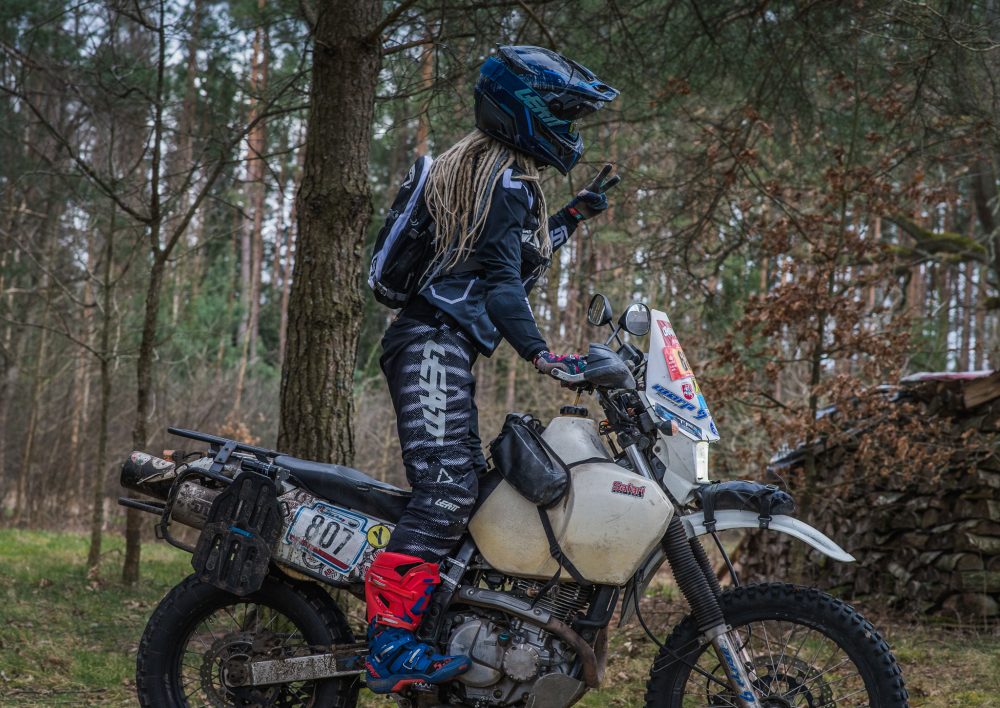
Once you find a comfortable standing position, practice staying supple and balanced. Tensing up is the worst thing you can do riding off-road. Think of yourself as being made of jelly – soft, supple, and malleable rather than rigid and stiff. Trying to keep your bike upright by sheer muscle power is impossible – gravity will always win over force, whereas balance will help you stay in control. Imagine you’re a piece of jelly pudding on a plate. If the plate is being shaken, the jelly moves with it… but doesn’t fall off.

That’s how it should feel riding standing up – the bike may move underneath you, but as long as you stay jelly, you’re near-impossible to shake off. Now imagine a hard marble on the same plate – it’ll bounce right off if shaken; the same goes for you if you tense up and become rigid. Stay jelly, and you’ll stay upright.
Steering and Climbing Hills
Once standing on the pegs begins to feel natural (or, at least, more comfortable), you can begin to experiment with your body position and weight. Generally, if you’re going uphill, you’ll want to shift your body and weight forward and feel the bike’s engine pushing you up through your feet to stay balanced. If you cling to the bars with your weight back riding uphill, you’ll likely lose momentum, stall, tip over, or achieve all three in one go. Shifting your weight forward when climbing allows you to remain balanced.
Equally, when going downhill, shift your weight and body back bending your knees – it looks almost like you’re sitting down, except without touching the seat. This way, you leave the front wheel light and put your weight on the back to keep the bike steady.
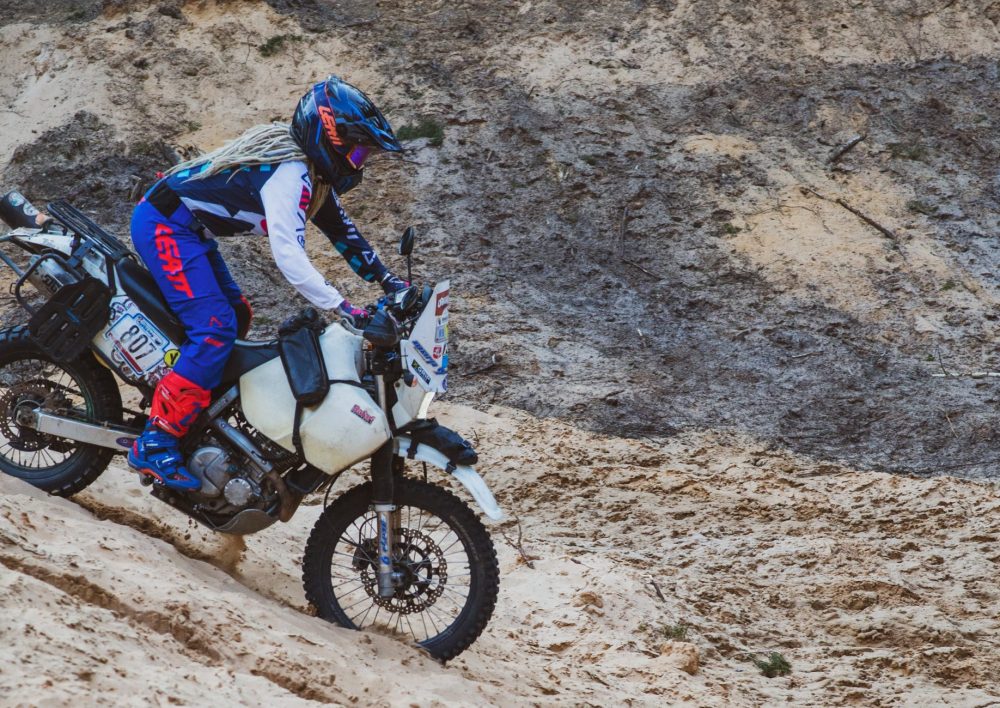
With turns on dirt, the trick is to – again – compensate for the loss of grip with your body position and weight. The bike on dirt will lean into the corner, but instead of leaning with it, you’ll need to learn to lean the other way and compensate for the lean angle with your body position and weight.
Finally, think about braking. On dirt, your braking distance will be longer, and it’s never, ever a good idea to grab or slam the brakes. Instead, feather them, and plan your stops and slower speeds in advance, especially when you’re on a loose, slippery surface like fine gravel and mud. Practice engine braking whenever you can – this will help you on steeper downhills and corners and allow for more control and stability.
Looking Ahead and Planning Your Lines
As a street rider, you already know about target fixation and looking through to where you want to go as opposed to where you don’t want to go. The same applies to dirt: if you see a scary rock and stare at it, you’ll end up hitting it. Instead, look at something beyond the rock, and you’ll effortlessly avoid it.
Speaking of rocks: as an adventure rider, you’ll learn to ride over obstacles, bigger or smaller, in your own time. Whether you’ve already mastered obstacles or not, however, planning your lines is key for a smooth ride.
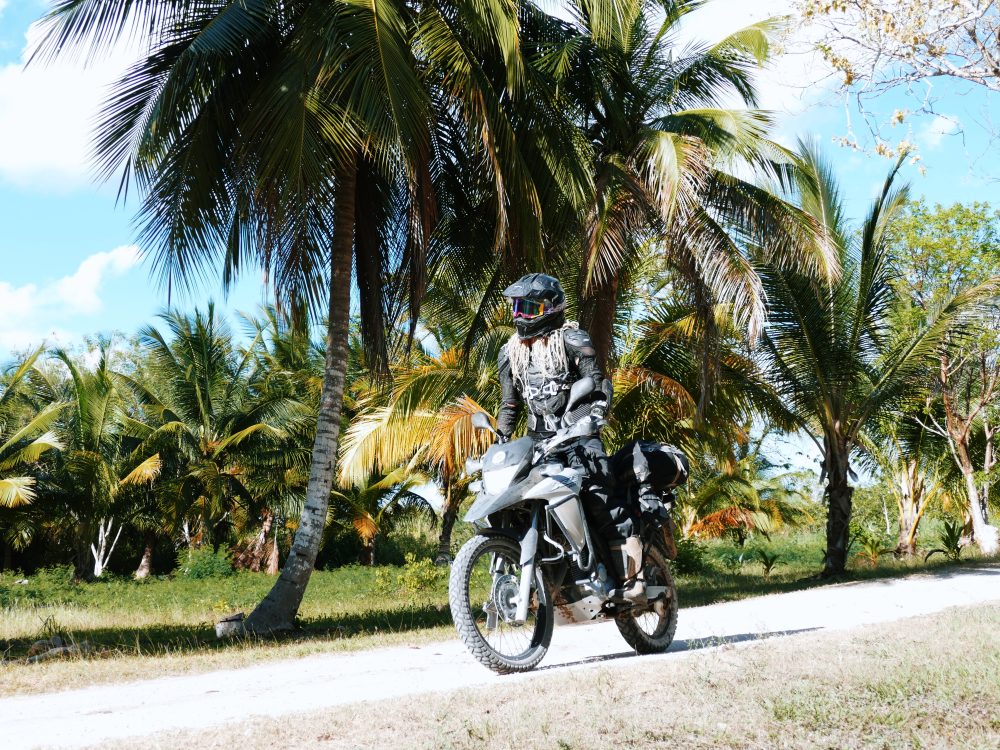
What does that mean? Imagine you’re riding a puddle-riddled trail: instead of plowing through the mud, pick a line that weaves around it. Why? It just makes your life easier – besides, you never know just how deep those puddles might be, and hitting one at speed can result in getting splashed with mud from toe to helmet peak or, worse, an unwanted flight over the bars. If you’re facing ruts, rocks, puddles, or any other obstacles, plan good lines ahead and stick with them – there’s no need to soak up every single bump, stone, and hole in the ground.
Putting Skills into Practice: Adventure Riding for Fun
Whether you transition from street to adventure riding on a large ADV motorcycle, a dual sport, or a dirt bike, there are two important things to remember: putting your skills into practice…and having fun. Whenever you can, take your bike out for a spin – it can be nice and easy hard-packed dirt roads, forest service trails, or just your own backyard. The more time you spend in the saddle, the better you’ll get.
If it doesn’t feel safe to ride solo just yet, join a local riders’ group, reach out to adventure motorcycle communities online, or join a women’s motorcycle tour – these can be fantastic for combining skill building, travel, and boosting your confidence.
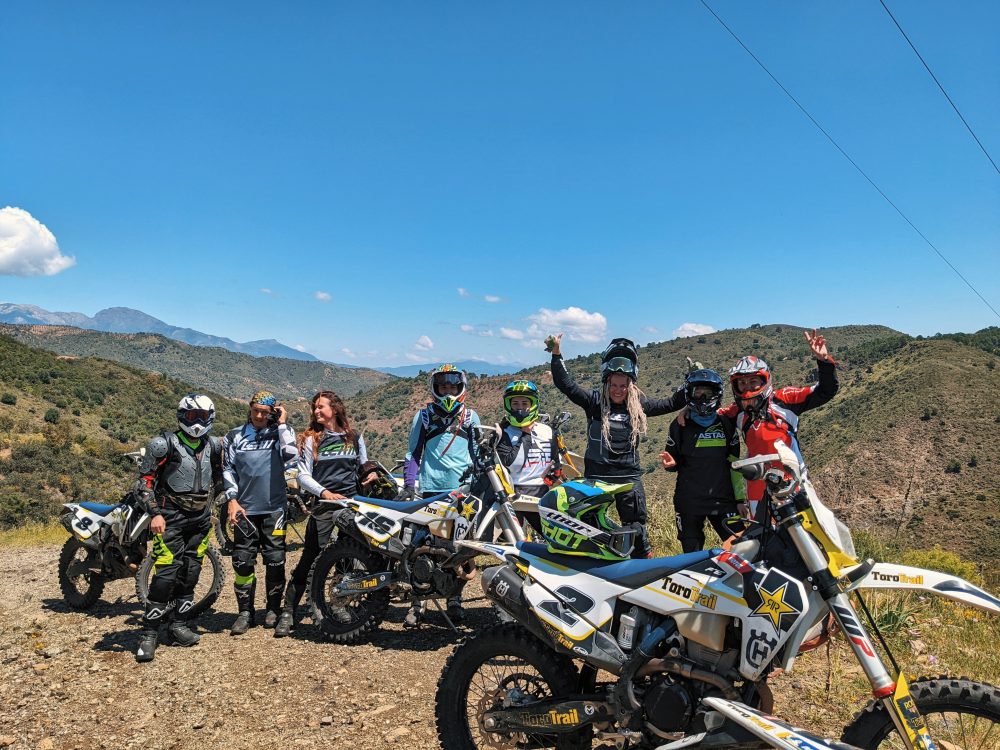
Remember, you don’t need to hit any milestones: adventure riding is all about the adventure itself. Some people progress faster than others, and that’s perfectly normal. It’s not about power slides, desert riding, or jumping logs – rather, it’s about confidence and joy. Instead of thinking “I should be able to ride dirt faster” or “I should be riding singletrack by now”, set different goals for yourself – for example, “I want to feel more comfortable in sand” or “I want to build on my endurance”. Wheelies look cool, sure – but feeling confident and experiencing the sheer joy of adventure riding is a lot more important than neat tricks or fast speeds.
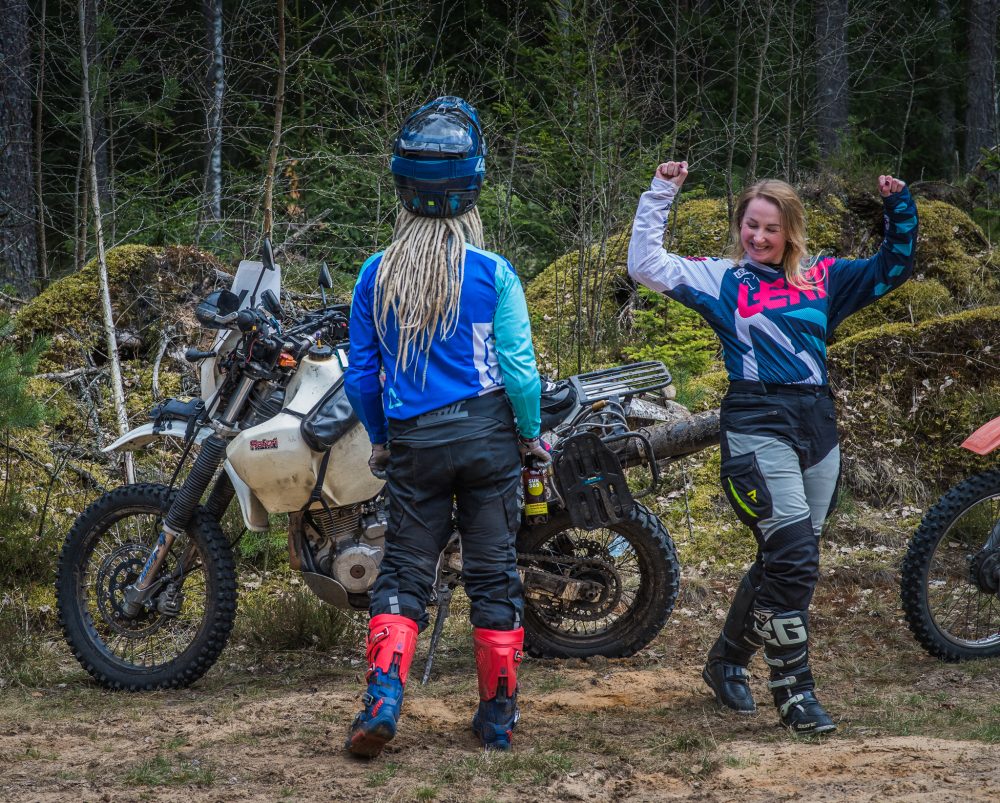
Mental Skills for Beginner Adventure Riders
Learning to ride dirt is more about what’s in your head rather than your physical fitness or even skill level. Overcoming fear, trying new things, taking risks, and gaining confidence is incredibly important, especially for women riders – for generations, we’ve been conditioned not to take risks and not to go on adventures, and doing so can feel daunting. And yes, that sort of conditioning may be a thing of the past, but the effects linger, and female riders tend to underestimate themselves much more than their male counterparts – even when they’re objectively good.
The mental skills aspect of adventure riding deserves an in-depth article of its own. However, there are a few simple tricks and techniques that can help you feel more confident and tackle your fears head-on:
Breathing
That’s right, just breathe: whenever you feel there’s an “oh shit” moment coming – you spot a deep rut too late or realize you’re heading toward a puddle you don’t particularly wish to face – just catch yourself and take a long breath in. Don’t hit your brakes, don’t make any sudden movements, don’t swerve madly – just take a deep breath. As you’re exhaling, the obstacle will already be behind you.
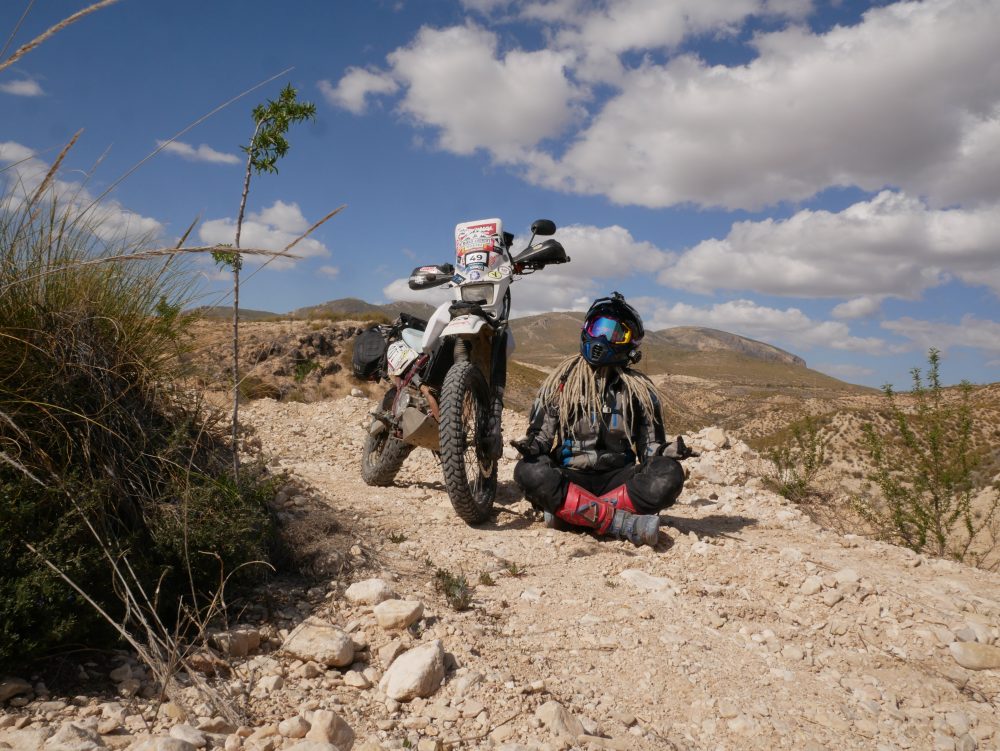
Adventure bikes are meant to take on ruts, rocks, and puddles, and often it’s your confidence rather than the bike that’s hindering you. Conscious breathing can help – by focusing on your breath rather than The Scary Thing Ahead, you shift your attention away from fear and suddenly realize the Scary Thing is already behind you.
Being OK With the Drops
When you transition from street to adventure riding, dropping your bike feels like a big no-no. It’s different when you ride dirt, though: everyone drops their bikes. Sometimes frequently. And, trust us, that’s OK. That’s not to say you’ll be falling off every ten miles, but tip-overs will happen – mostly, at slow speed and on soft surfaces – and that’s perfectly normal. Adventure, dual sport, and dirt bikes are designed to withstand some abuse, and it’s totally OK to fall off every now and then – protection and safety first, of course, but don’t let those falls get into your head. If they do, just browse #bikenap photos on Instagram and you’ll see you’re not alone.
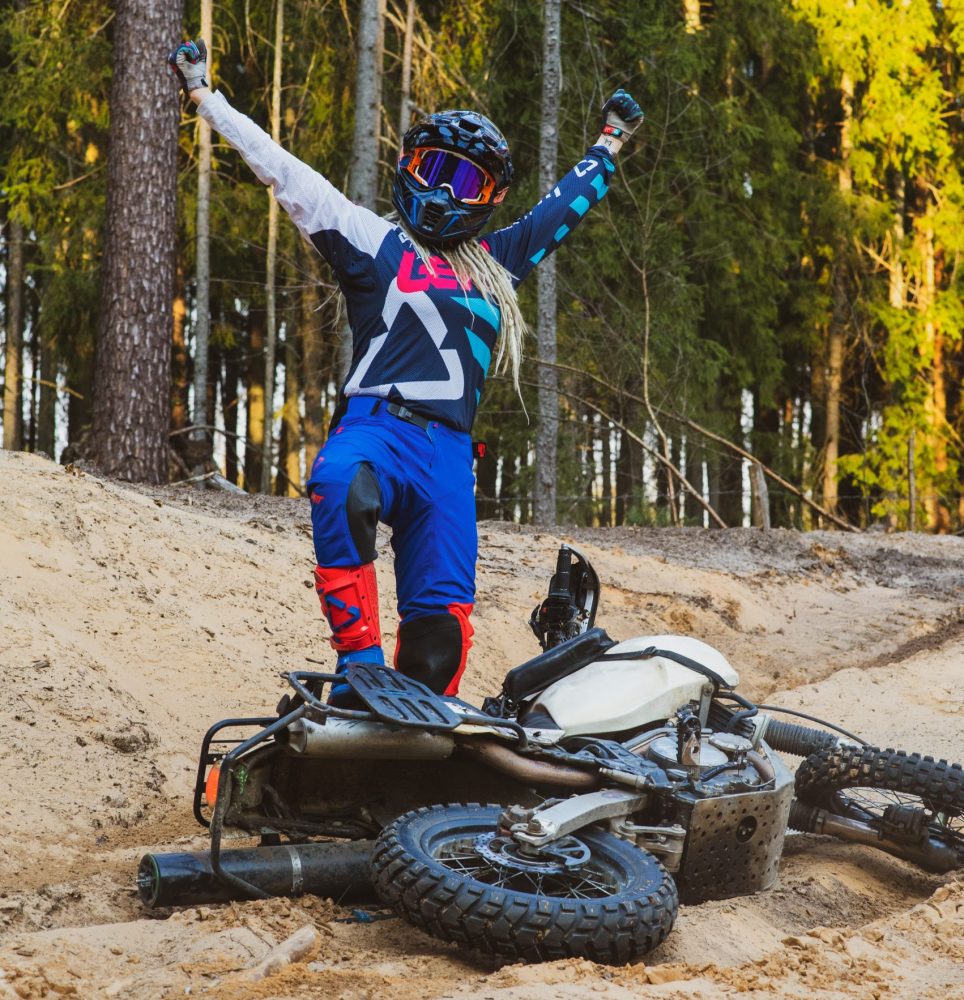
Looking ahead
We already talked about target fixation, but there’s another aspect to planning your lines: it allows you to ignore the seemingly scary surface (say, loose gravel) or small obstacles like rocks or ruts and ride smoothly. Imagine you’re going downhill, the surface is a little loose, and there’s a small dip at the bottom of it. Instead of focusing on the surface or the dip, fix your eyes to the furthest point you can see, look at it, and ride ignoring everything that’s happening under your tires. When you look ahead to the furthest point, your body naturally adjusts for the right position, you ride consistently instead of nervous jerks and sudden braking, and, before you know it, you ride the whole thing out. Practice this consciously as often as you can, and you’ll soon find your confidence growing.
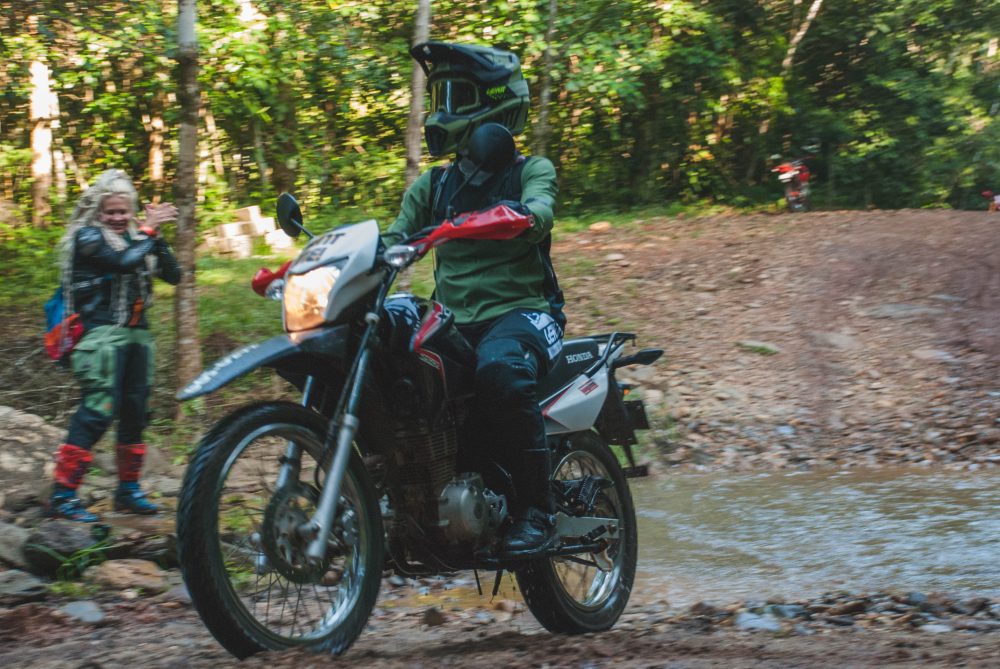
There’s a lot more to be said about dirt riding skills, techniques, and mental skills, but we hope this article helped you to get a bit more of an idea of how to transition from street to adventure riding. Remember, progress at your own pace, choose the bike that fits your needs, and, most importantly, enjoy the ride – and the adventure.
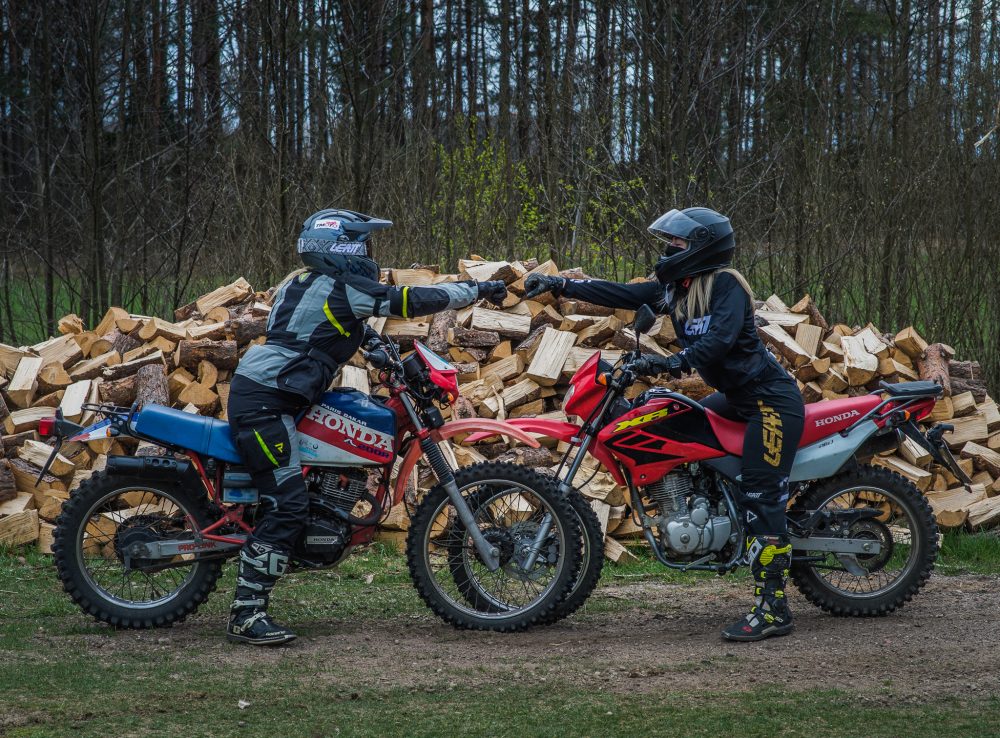
Transitioning from street to ADV? Have questions or comments? Let us know in the comment section below – we’d love to hear from you!
